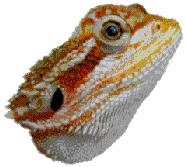- I. DESCRIPTION:
This unusual mid-sized stocky agamid lizard has prominent spines along its sides and a large, essentially triangle-shaped head. Forming a sort of shield around the snout is a spiney jaw pouch which, when swollen, looks like a beard and makes any predator think twice before attacking. This wide-ranging species shows considerable geographic variation; its basic color varies from shades of brown, gray, and reddish-brown to bright orange. The ventral surface ranges from pale to dark gray, with white elongated spots edged with black. Mature males have dark "beards" which become black during courtship and breeding. Adults can grow as large as ten inches in body length or two feet in total length, including the tail. Males are larger than females. - II. GEOGRAPHICAL RANGE AND HABITAT:
These lizards are native to Central Australia. They prefer semi-arid to arid woodland habitats. Time is spent both on the ground and in trees. They may be found perched on bush branches and even on fence posts. - III. DIET:
Bearded dragons are omnivorous and consume many types of insects, small vertebrates, and vegetation including fruits and flowers. - IV. LIFE CYCLE/SOCIAL STRUCTURE:
Sexual maturity is reached at one to two years of age. Mature females typically lay clutches of eleven to sixteen oblong leathery eggs in early summer. The eggs are laid in nests dug in sandy soil and the unattended young hatch 3 months later. - V. SPECIAL ADAPTATIONS:
A bulky body and the habit of basking allows them to store heat, making it possible to operate at lower temperatures than other lizards. They can also survive higher temperatures for several hours, since they can regulate body temperature by evaporation.
VI. INTERPRETIVE INFORMATION:
When intimidated, they flatten their bodies and stand erect with mouth gaping. The light-colored mouth lining, spines
bordering the lower jaw and puffed-out blackish beard give a formidable appearance. This defensive display has earned
these lizards the common name of "bearded dragon".
Aggressiveness to other members of the group is shown through "body language". The tip of the tail is slightly curved
at the end and the head is bobbed rapidly. Submission is signaled by rotating the arms in a full circular motion, which
looks a bit like waving. Ritualistic sparring matches take place in which both animals are in flat postures, beards and
tails up and outward; they circle each other, biting at one another's tail, but usually no damage is done.
Their ability to change shades of color, from light to dark, helps them to regulate body temperature. Color changes can
also depend on emotional state, and may also be used for concealment. When injured, sick, or dying the back becomes
black and the legs pale yellow.
Australian desert lizards often make their escape by rising on their hind legs and running bipedally. They cannot run
as fast as when using four feet, but perhaps this behavior aids in temperature control. They lift their bodies from the
hot ground to lose the heat they generate in running. This reduces the amount of heat they take in from the ground and
increases the cooling airflow over their bodies.

VII. STATUS IN WILD:
Not considered endangered or threatened.
VIII. BIBLIOGRAPHY:
- Encyclopedia of Reptiles, Amphibians, and other Cold-Blooded Animals. Burton, Maurice. 1975. Octopus Books Ltd, PP 160-161.
- "The Inland Bearded Dragon" , The Vivarium, Vol. 4, No. 5., Mar/Apr 1993.
- "The Social Life of Bearded Dragons". Zoonooz, June/July, 1995. San Diego Zoo.
